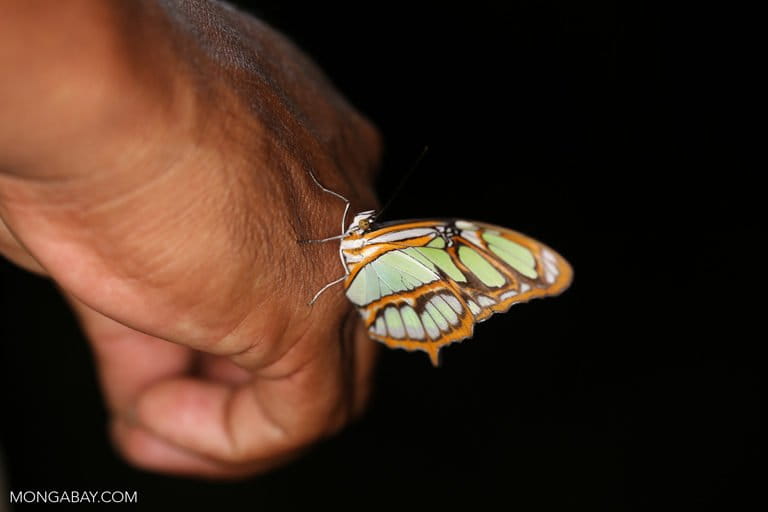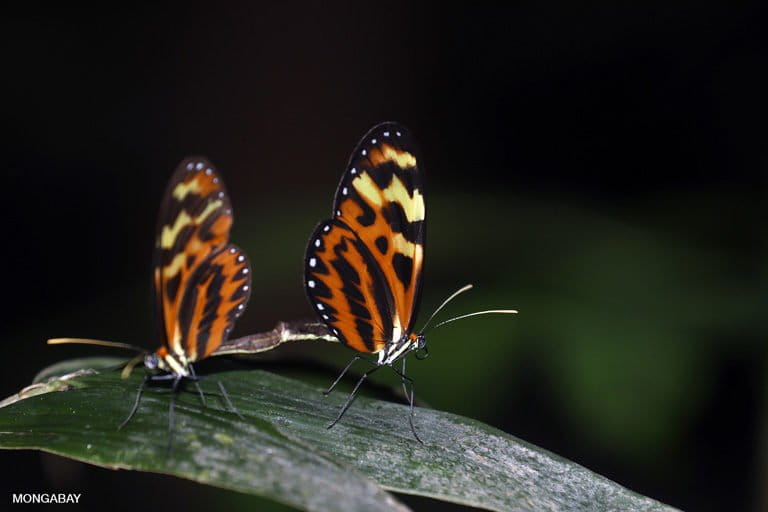- In recent years, many cities have set up butterfly parks. While these may be useful for awareness, they may not help in conservation, state experts.
- Like bees, butterflies are also crucial in pollination, play an essential role in the food chain and are indicators of a healthy ecosystem.
- An increase in pesticide use, deforestation, and climate change are some of the causes of habitat loss of butterflies.
Colourful and delicate, butterflies are not only beautiful creatures, but also play an essential role in the food chain as well as being indicators of the ecosystem.
Of late, butterfly parks are emerging as a new trend with recent ones coming up in cities like Bhopal and Indore in Madhya Pradesh. States like Karnataka, Maharashtra, Himachal Pradesh, Sikkim, Bangalore, Punjab, and Uttar Pradesh already have many such parks.
“Around three dozen species including butterflies like blue tiger, plain tiger, striped tiger, common banded awl can be seen in our park,” said A.K. Jain, deputy director of Van Vihar National Park, Bhopal. “We wanted to make people aware of butterfly conservation. We also encourage our visitors to plant nectar and host plants to attract butterflies in their backyard. We prepared a leaflet containing all the information.”
“Nectar plant and host plants are important for butterfly habitat. Sunflower, marigold, lantana, petunia, hibiscus are some common nectar plants in India. Butterflies depend on these plants for food. Curry leaves, cotton trees, cassia, citrus, are some example of host plants. These are the plants where eggs are laid, larvae, caterpillars and pupa are formed,” Sarang Mathre, a Bhopal-based butterfly park consultant, told Mongabay-India. Mathre has helped authorities and some private organisations to build butterfly parks in Madhya Pradesh.

While the number of such parks is growing, are they capable of conserving butterflies at a large scale? Krushnamegh Kunte, PhD and Associate Professor, National Centre for Biological Sciences (NCBS) said, “You should distinguish between butterfly parks and butterfly conservatories. Butterfly parks are great for outreach and education, not for conservation. Conservatories are valuable for conservation in urban as well as more wild habitats, and for conservation breeding of endangered and threatened species.”
“The breeding programme has to be well thought out, and there should be sufficient releases of lab-raised butterflies in habitats that are also being improved. Conservation of habitat, larval host and nectar plants, and breeding in the butterfly conservatories has to be done simultaneously,” he told Mongabay-India.
Kunte said that parks like the one Bhopal would be great for creating awareness about butterflies, their caterpillars, their interesting interactions with plants, and connecting especially young people with insect biodiversity.
Butterflies losing habitat to forest degradation
Despite small efforts like butterfly parks, the large scale problem of forest degradation is causing habitat loss for butterflies, important in the food chain and ecosystem.
A report compiled by Mongabay said that India lost 1,625,97 hectare of tree cover during the year 2001 to 2018. It is 19.1 percent of the total tree cover.
The National Forest Commission report 2006 indicated that around 41 percent of the country’s entire forest is already degraded, 70 percent of the forests have no natural regeneration, and 55 percent of the forests are prone to fire.
“Forest fires, degradation of forest and climate change altogether affect many species of butterflies. However, due to a lack of research, it is impossible to say which species are on the verge of extinction. Still, we are indeed losing butterflies in India,” said Sanjay Sondhi, a Dehradun-based naturalist and founder trustee of Titli Trust. The trust is working on research and conservation of butterflies in the Himalayas.

In a 2017 study from the western Himalayas, three researchers — Deepika Mehra, Jagbir Singh Kirti, and Avtar Kaur Sidhu— from Punjabi University, Patiala, used published data and field observations (from 2013 to 2016) to appraise the status of biodiversity and conservation of butterflies in the western Himalayas. The paper published in the Journal of Entomology and Zoology stated, “A total of 493 butterfly species referable to 219 genera were reported from Western Himalaya, out of which, 89 species (60 species are narrowly endemic) i.e., 18 percent were found to be endemic.” The Himalayan range extending from Jammu & Kashmir, Himachal Pradesh up to Uttarakhand is known as Western Himalayas. The study found that 493 butterfly species are recognised from the Western Himalayas, constituting approximately 30 percent of the total Indian butterfly fauna.
Butterflies face multiple threats across the globe
A report by the Food and Agriculture Organisation of the United Nations says that close to 35 percent of invertebrate pollinators, particularly bees and butterflies, and about 17 percent of vertebrate pollinators, such as bats, face extinction globally.
“There has been a worrisome decline in the population of pollinators, especially bees and butterflies, mainly due to intensive agricultural practices, changes in land use, pesticides (including neonicotinoid insecticides), alien invasive species, diseases, pests, and climate change” the report added.

Another report by FAO stated that more than 75 percent of the world’s food crops depend, to some extent, on pollination. “Pollinators, like bees, butterflies, birds, moths, beetles, and even bats, help plants reproduce,” report added.
Illegal trade in butterflies is another threat to the creatures. The Zoological Survey of India published a ‘Red Data Book on butterflies of India‘ in the year 2005. The authors of the book I.J. Gupta and D.K. Mondal estimated that the world’s illegal butterfly trade is worth US$ 100 million (Rs. 7.3 billion).
“Butterfly trading based in India and Indo-China is now quite extensive and occurs at all levels, from personal collectors to substantial business. About no less than 50,000 specimens of butterflies are smuggled out of India every month. Also, the butterfly -collecting for illegal trade is prevalent in Western Himalaya (Himachal Pradesh, Ladakh and North-western parts of Uttar Pradesh), the Eastern Himalaya (Sikkim and in the north of West Bengal) and the Western Ghats,” it added.
Need for conservation
Emphasising on the need for butterfly conservation, Kunte said, “There is a need for a butterfly conservation program in India, but not through parks or conservatories alone. If we are losing and degrading habitats, then conservation programmes will not succeed. So, butterfly conservation cannot be seen in isolation, similar to any other significant conservation programme.”
“Conservation of wild habitats is of paramount importance. Without that, there is no future for Indian biodiversity. Corridors among increasingly fragmenting habitat patches are also important since butterflies cannot easily cross densely built-up areas and those with heavy and fast-moving vehicular traffic,” Kunte added.
“Improvement of already degraded habitats is necessary, wherever feasible. It may be done by encouraging the growth of native biodiversity-friendly vegetation, as forest departments in Karnataka and West Bengal have done in several butterfly habitats in and around otherwise heavily populated urban and rural areas,” he said.
Read more: Splintered habitats may imperil egg-carrying butterflies
Banner Image- Nectar plant and host plants are important for butterfly habitat. Sunflower, marigold, lantana, petunia, hibiscus are some common nectar plants in India. Photo by Rhett A. Butler/Mongabay
